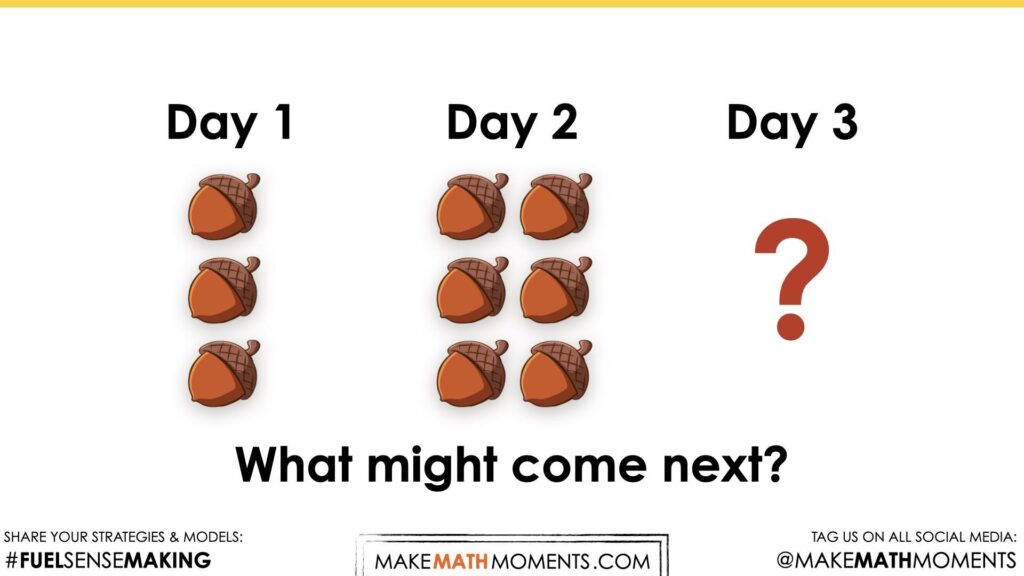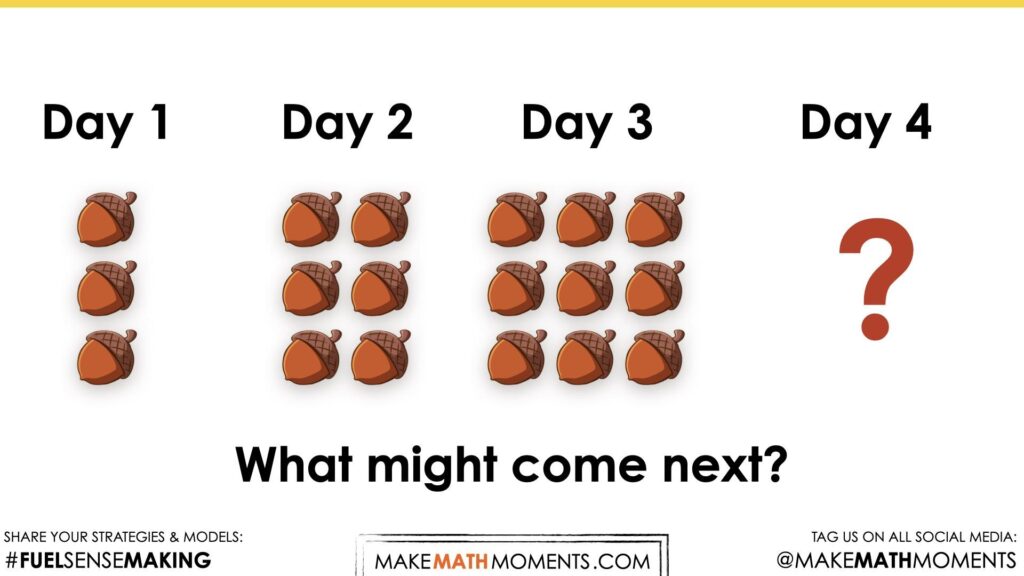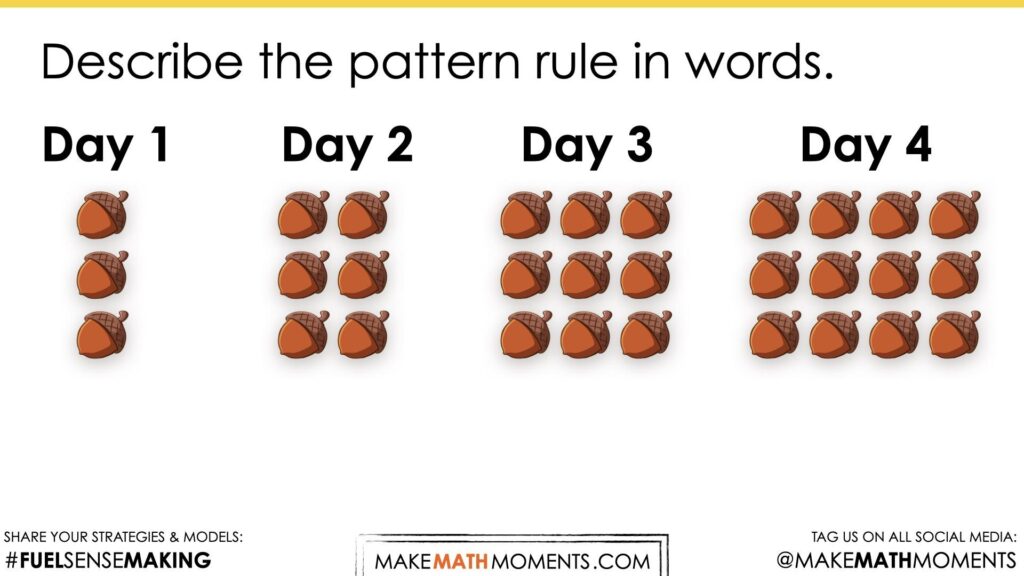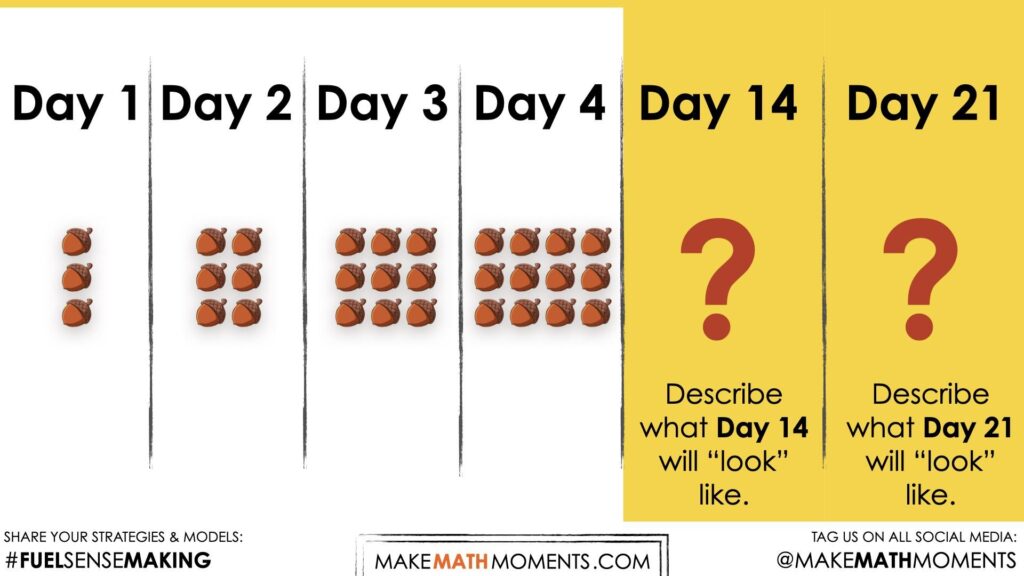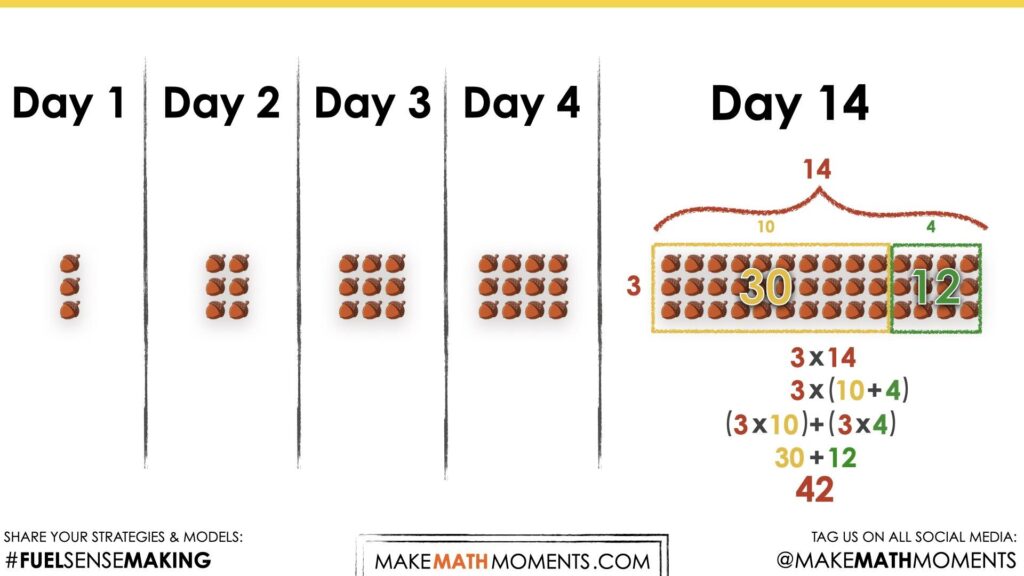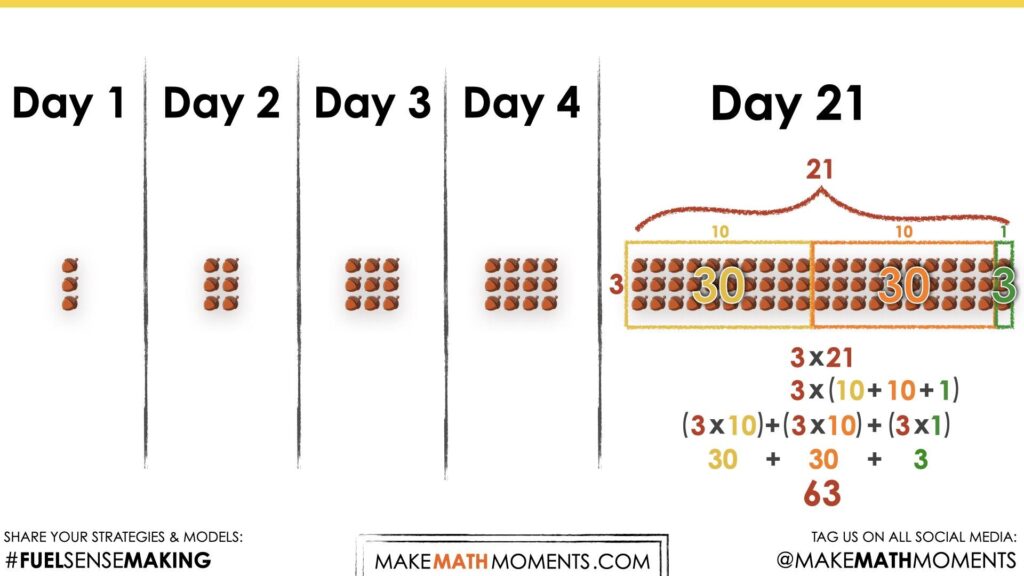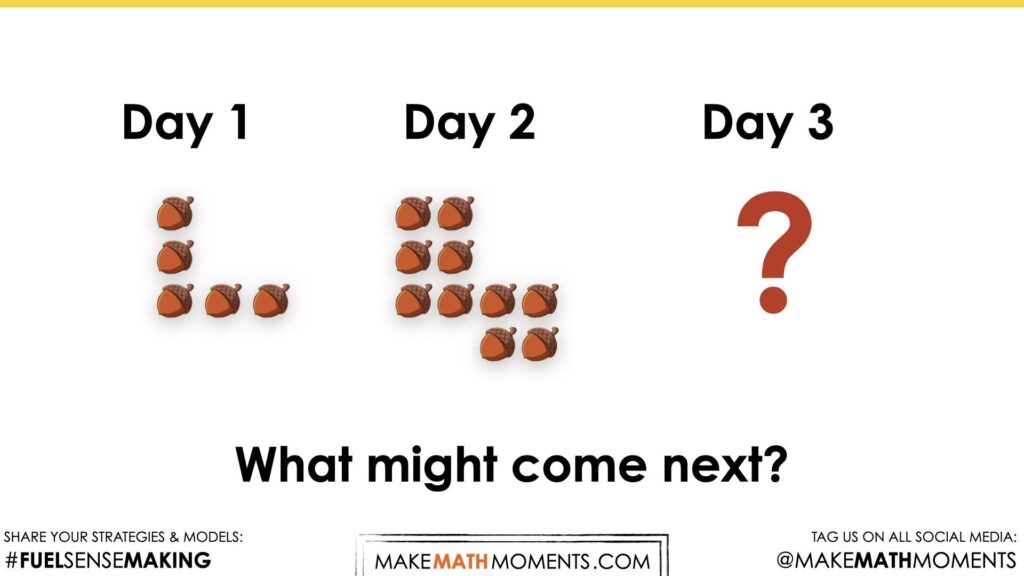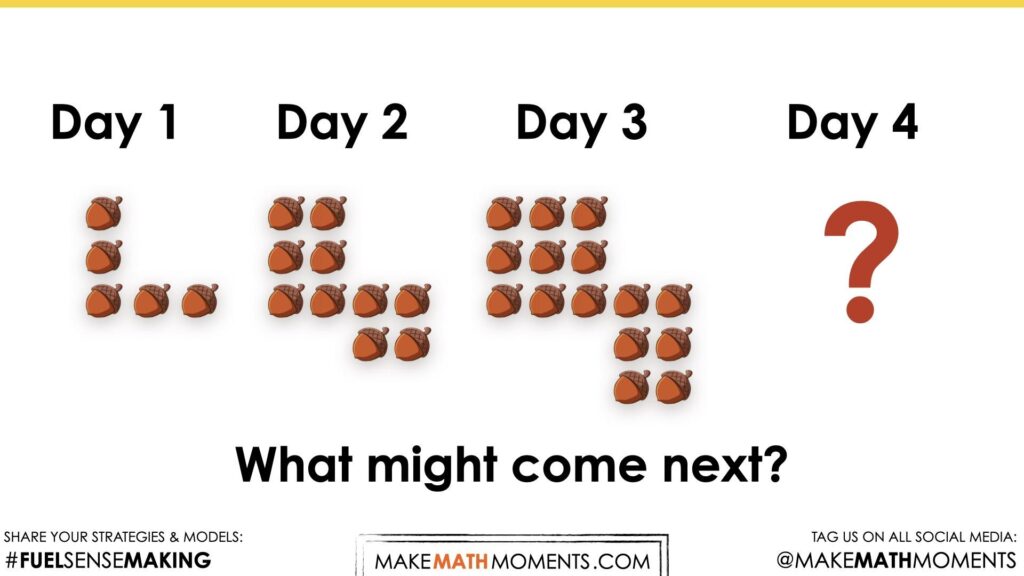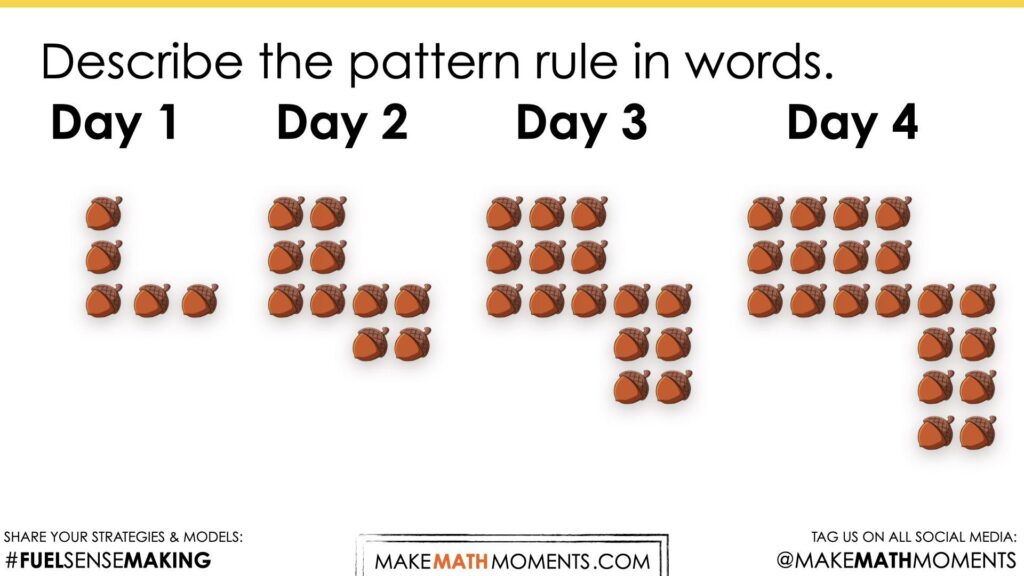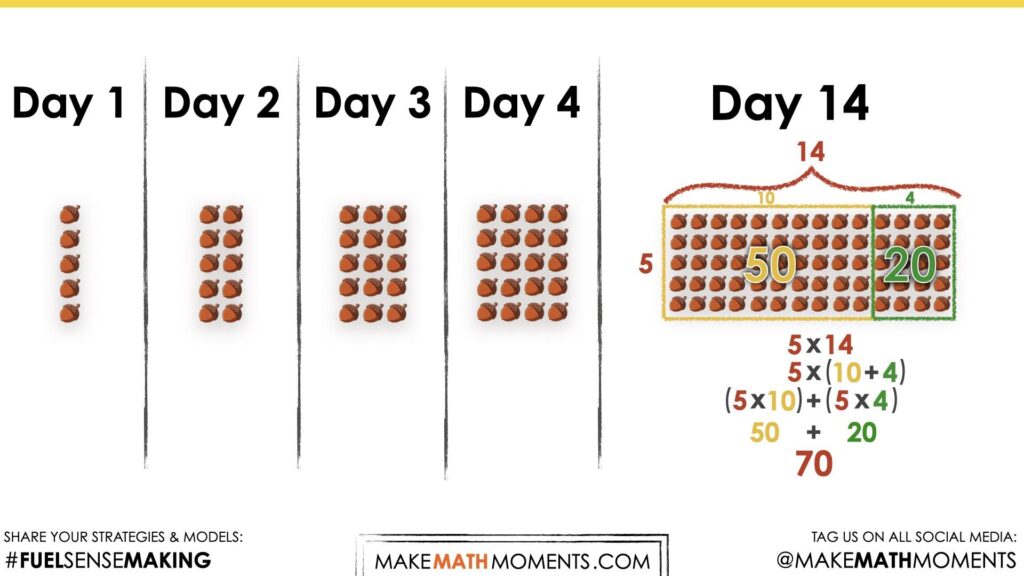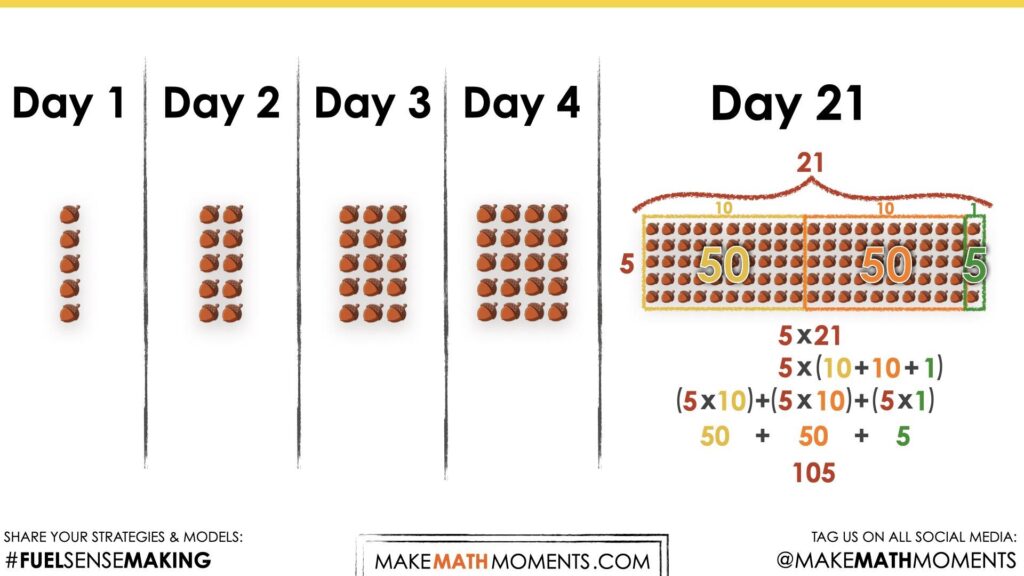ACORN HOARDING [DAY 2]
GROWING & SHRINKING LINEAR PATTERNS
Explore growing & shrinking visual patterns and linear relationships by constructing pattern rules in words, tables of values and equations.
Intentionality
Math Talk
Visual Math Talk Prompt #1
Visual Math Talk Prompt #2
Visual Math Talk Prompt #3
Purposeful Practice
Resources & Downloads
Educator Discussion Area
Intentionality & Unit Overview
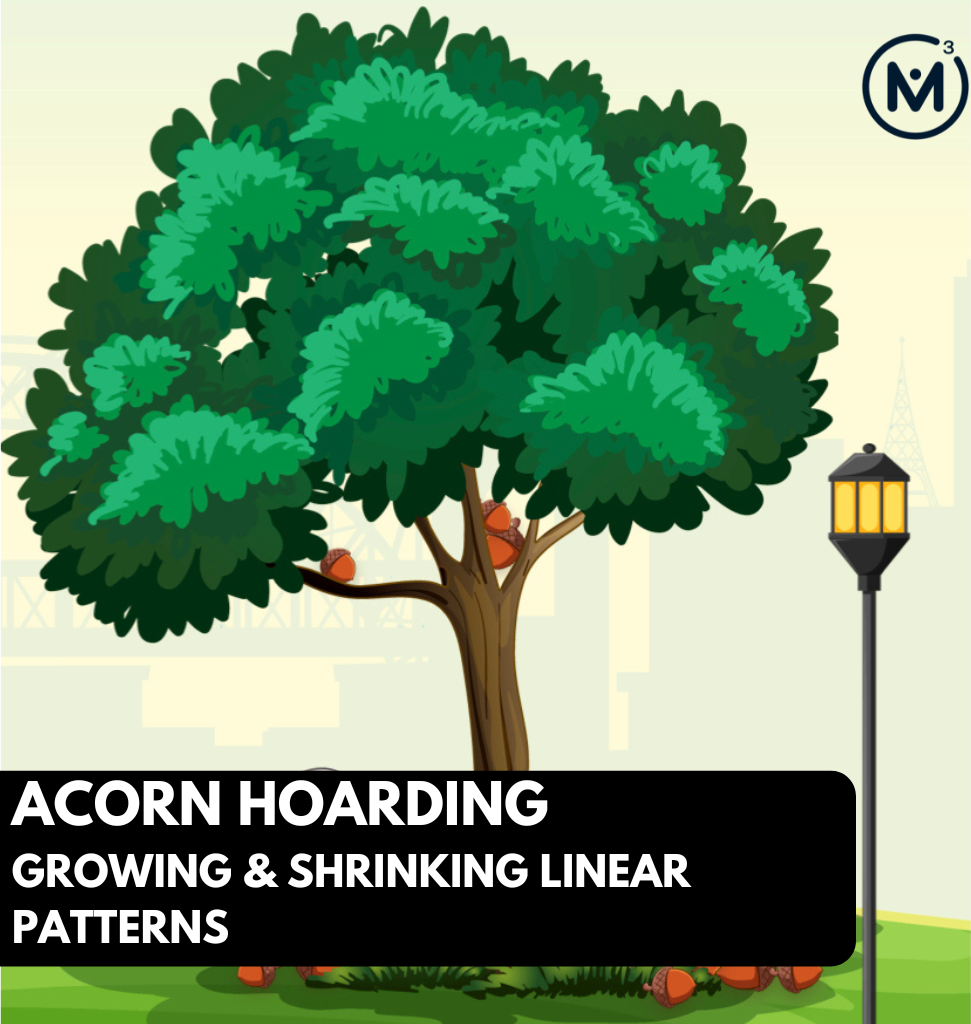
Length of Unit: 5 Days
Access each lesson from this unit using the navigation links below
Students will extend growing linear visual patterns, make near and far predictions and describe visual patterns in words.
Intentionality…
The purpose of the Day 2 activities is to reinforce key concepts from Day 1. Students will engage in a visual number talk using visual patterns (geometric patterns) and will have an opportunity to complete independent purposeful practice. The number talk and purposeful practice serve to develop a deeper understanding of the following big ideas.
- Patterns can be extended because they are repetitive by nature.
- Pattern rules are generalizations about a pattern, and they can be described in words.
- A pattern can be extended to make a prediction.
- For far predictions, calculations are required for efficiency.
- In a growing pattern, the values increase.
- In a linear pattern, the values increase at the same rate.
- Graphical representations of linear growing patterns appear as straight lines.
Math Talk
Present the following visual patterns through the visual number talk prompt videos below. Leverage the day one context of an animal hoarding nuts, seeds or fruit in preparation for the winter. For each pattern, ask students to describe the pattern rule in words and predict the value of the 14th day and 21st day. Students are encouraged to justify their thinking and educators are encouraged to facilitate this visual number talk by modelling student thinking using the mathematical model that will help give others a window into that thinking.
While the array model or area model would best suit the visual patterns shared and therefore we want to be intentional about seeking ways to best emerge the use of this model, be sure to acknowledge other models that students may have used including linear or symbolic models.
Look for opportunities to build efficiency. For example, rather than counting on or repeated addition, can students use partial products through scaling in the table? For example, the 14th term in the first pattern is the same as the fifth term, multiplied by two, plus the 4th term. Or see the multiplicative relationship between the term number and the term value?
Facilitator note: The pattern rule can be described two ways. For example, start at 3, add three each time. Or multiply the term number (in this context, the day) by three (the rate).
Visual Math Talk Prompt #1
Begin playing the following visual number talk prompt video and be ready to pause the video to allow for think time.
After the visuals for the first two days in the visual pattern appear, pause the video and share the following prompt:
Use manipulatives or draw what you think might come next.
At this point, it is important for students to understand that there is really no way to guarantee what will come next because we do not have enough information yet. Here are some of the predictions students might make and some possible reasoning:
- 9 acorns because the pattern is growing by 3 acorns per day;
- 12 acorns because the pattern is doubling each day.
- 3 acorns because the pattern is repeating; and,
- Other possibilities.
Next, show students the number of acorns in total on day 3 and ask them to make another prediction for how many acorns there will be on day 4.
You may notice that more and more students update their predictions to a pattern increasing by 3 acorns per day (a rate of 3 acorns/day).
Once we share how many acorns were collected over the first four days, we can ask students:
Assuming this pattern continues, describe the pattern rule in words to your neighbour.
As students continue discussing how they might describe the pattern rule, you can extend this prompt to:
Describe what day 14 and what day 21 will look like.
Articulate to students that the purpose of a pattern rule is to help someone easily understand how a pattern changes from day to day (or stage to stage, or figure to figure). In the case of a geometric pattern (or visual pattern), it is also helpful to describe how the visual pattern is growing without necessarily being able to “see” the pattern with their own eyes.
Some students might be able to articulate that day 14 should be a long 3 acorn by 14 acorn rectangle.
Since we promote students building number fluency and flexibility each and every day, this is an excellent opportunity for them to apply the multiplication strategy of partial products which leverages the distributive property to decompose the factor of 14 into smaller parts.
Above, you can see that this particular example shows 14 acorns decomposed into parts of 10 and 4 which ultimately produces the following equivalent expression:
3(10 + 4)
Not only does this promote an opportunity for students to multiply without a calculator to build fluency and flexibility with multiplication, but it also allows us to revisit order of operations and how blindly following the rules can actually create more work for us at times.
For example, if we simplify what is “inside the Brackets” (or Parentheses) as BEDMAS (or PEDMAS) would require, we would actually be doing ourselves a disservice.
Here, we know that 3 groups of 10 acorns is 30 acorns and 3 groups of 4 acorns is 12 acorns, resulting in 42 acorns total.
Of course, students are not limited to the distributive property here and are more than welcome to leverage other multiplication strategies such as doubling and halving or other strategies that feel helpful.
The description of day 21 is similar to that of day 14 and students might leverage similar or different multiplication strategies to yield their total number of acorns.
Visual Math Talk Prompt #2
Play the following visual number talk prompt video and be ready to pause the video to allow for think time.
After the visuals for the first two days in the visual pattern appear, pause the video and share the following prompt:
Use manipulatives or draw what you think might come next.
Again, give students an opportunity to turn and talk to predict what might come next. Offering them the opportunity to construct (using square tiles, for example) or draw what they might see next can be helpful for students to pay closer attention to how this visual pattern might be changing from stage to stage.
After revealing the figure for day 3, you can again ask them to update their predictions for day 4 followed by revealing day 4 and asking students to describe the pattern rule in words assuming it continues in the same fashion.
Similar to the previous visual pattern prompt, you can ask them to describe what the 14th and 21st days will look like.
Some students may approach this pattern by counting how many acorns are showing on each day and notice that it is increasing by the same rate of 5 acorns per day.
Other students might notice that if you were to shift the acorns from the bottom right portion of each figure down 1 row and rotate 90 degrees clockwise, they can construct an array with 5 acorns in each column. This can be written as an algebraic equation as:
N = 5d
This may provide an opportunity to dig into algebraic equivalence and the idea of collecting like terms to help connect student thinking to other areas of mathematics that they may or may not have explored previously.
Again, students are encouraged to determine the number of acorns on day 14 and 21 by first describing what each day might look like and then leverage their number sense strategies (no calculators) to continue building fluency and flexibility with number an operations.
Visual Math Talk Prompt #3
Login/Join to access the entire Teacher Guide, downloadable slide decks and printable handouts for this lesson and all problem based units.
Purposeful Practice
While Students Are Practicing…
Login/Join to access the Purposeful Practice as well as the Teacher Guide, downloadable slide decks and printable handouts for this lesson and all problem based units.
Questions: Growing Linear Patterns
Question #1:
Login/Join to access the full teacher guides, downloadable slide decks and printable handouts for this lesson and all problem based units.
Question #2:
Login/Join to access the full teacher guides, downloadable slide decks and printable handouts for this lesson and all problem based units.
Question #3:
Login/Join to access the full teacher guides, downloadable slide decks and printable handouts for this lesson and all problem based units.
Question #4:
Login/Join to access the full teacher guides, downloadable slide decks and printable handouts for this lesson and all problem based units.
Question #5:
Login/Join to access the full teacher guides, downloadable slide decks and printable handouts for this lesson and all problem based units.
Question #6:
Login/Join to access the full teacher guides, downloadable slide decks and printable handouts for this lesson and all problem based units.
Resources & Downloads
Login/Join to access the entire Teacher Guide, downloadable slide decks and printable handouts for this lesson and all problem based units.
Educator Discussion Area
Login/Join to access the entire Teacher Guide, downloadable slide decks and printable handouts for this lesson and all problem based units.
Explore Our 60+ Problem Based Units
This Make Math Moments Lesson was designed to spark curiosity for a multi-day unit of study with built in purposeful practice, number talks and extensions to elicit and emerge strategies and mathematical models.
Dig into our other units of study and view by concept continuum, grade or topic!


